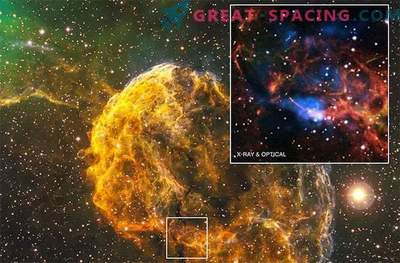
Canadian astronomers have detected mode changes and large-scale pulses in a millisecond pulsar PSR B1957 + 20. This is the first time that a change in the mechanism of behavior is observed in such an object.
Radio pulsars exhibit varying variability in emissions: from extremely short bursts to long-term changes in profiles. Some of them also demonstrate changes in behavior when radiation profiles are switched between two or more quasistable radiation modes. Today, a change in the mode was observed only in normal pulsars. But a recent study from scientists at the University of Toronto (Canada) showed that the process of behavior change may also be present in millisecond pulsars. It managed to turn out at PSR B1957 + 20 when switching between two modes.

Image PSR B1957 + 20 from Chandra. Blue and green are optical images of the field in which the pulsar was found, where the H-alpha shock wave is also marked green. Red and white are secondary impact structures found by the Chandra X-ray Observatory The object PSR B1957 + 20 was first noticed in 1988. This is a damped binary millisecond pulsar on the territory of the constellation Strela. Rotates with a brown dwarf at intervals of 9.2 hours and a blackout time of 20 minutes. The pulsar was monitored from June 13-16, 2014 at the Arecibo Observatory (Puerto Rico), which led to the detection of oddities in behavior.
The analysis showed that PSR B1957 + 20 switches between two modes, where the typical time between mode changes is only 1.7 seconds. This is the shortest time period of a change in the mode of a pulsar, observed so far by scientists. Most often, the rate reaches from a minute to several weeks.
The pulsar is in high mode at about 60%, and in the small - 35% of the total time. The remaining 5% is allocated to the transition. Also, a review from Arecibo showed 1,715 giant pulses in PSR B1957 + 20. Their properties correlate with the regime of regular radiation, that is, the speed and rotational phase are based on the behavior of the pulsar. Additional observations will allow you to find out the reasons for changing the regime.











































